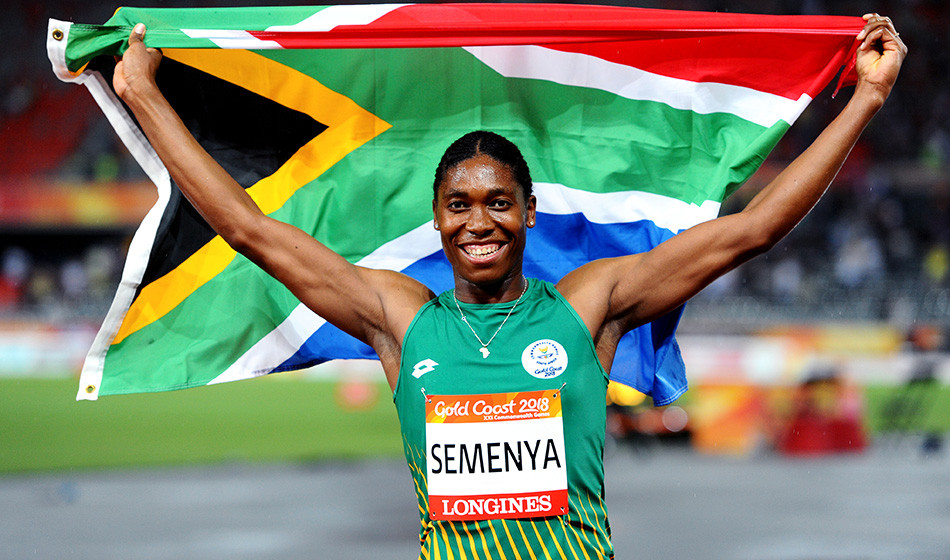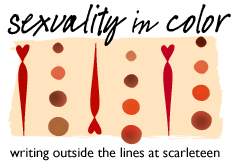Caster Semenya is a gold-medal-winning Olympic athlete from South Africa. She's an incredibly talented runner who's won dozens of gold medals at competitions worldwide. But instead of having her athletic performance attributed to natural talent and hard work, it has been scrutinized and coupled with assertions that she can’t possibly have accomplished what she has without cheating.
Who is to blame for this, you might ask? Just the usual suspects: sexism , cissexism, and white supremacy.
In August of 2009 Caster Semenya came in first for the 800m dash (and set an annual record!) at the World Championships. She should have been able to celebrate her first international victory, but some folks became suspicious that she showed “rapid improvement” because her finish time was four seconds faster than one that she made one month earlier at the African Junior Championships. As a result, the IAFF (International Association of Athletics Federations) forced her to take a “ sex verification test”, which appears to consist of a series of biomedical procedures and tests that vary in their degrees of invasiveness.
The fact that this test was sanctioned and conducted at all is bad enough, but to make things worse, some of Semenya’s private health information was also leaked to the media. By insisting that she submit to testing and subsequently failing uphold confidentiality, the IAFF and its entities violated Caster Semenya’s right to privacy, and also reinforced the narrative of public inquiry and scrutiny about Semenya’s integrity and personal legitimacy.
Her body became the subject of international debate and spectacle, much like Saartje Bartmann and countless other Black and brown bodies that were put on display at the hands of Western medical and scientific institutions throughout global history.
Fast forward to April of 2018, when the IAFF announced revisions to their policies regarding “differences in sex development” for female athletes.
They were already in an ongoing legal case (Dutee Chand v. Athletics Federation of India (AFI) and The International Association of Athletics Federations) about their discriminatory practices, but they doubled down and took things a step further. They declared that female athletes with “hyperandrogenism” (higher-than-average levels of testosterone that are naturally produced in the bodies of some people assigned female sex at birth) would be required to undergo treatment via medication to lower their testosterone to arbitrary, pre-defined levels before they would be allowed to compete. This demonstrates a total lack of understanding of complexities of sex, bodies, and gender – as if being a female is defined by a certain number of milligrams of testosterone present in one’s blood, or there’s not an array of diversity when it comes to testosterone levels among women. It forgets that the general concept of “biological sex,” flawed already, isn’t composed of half a dozen internal and external traits that can vary hugely from individual to individual and fluctuate over a lifetime. It also takes the often-used approach to bodies that show these variations – “let’s use a biomedical intervention to fix it so that it’s more like everyone else.” — instead of accepting them as one of many vast variations.
 I don’t know all that much about competitive sports, but something that I’ve consistently heard about the Olympics is that it’s supposed to be a gathering of some of the world’s most talented and physically impressive bodies. If that’s true, then the miniscule athletic “advantage” of a naturally slightly higher level of testosterone in a female athlete’s body shouldn’t bother the IAFF any more than other inherent physical traits that can or do create advantages, like longer legs or wider hips. In reality, we see plenty of male athletes such as Michael Phelps or Usain Bolt revered for their better-than-average physiques. But the true intentions of these policy changes (and the
cherry
on
top
of a great big discrimination sundae) became evident when we learned that the policies only applied to athletes competing in 400m, 800m, 1500m, and hurdle combination events – Semenya’s only events.
I don’t know all that much about competitive sports, but something that I’ve consistently heard about the Olympics is that it’s supposed to be a gathering of some of the world’s most talented and physically impressive bodies. If that’s true, then the miniscule athletic “advantage” of a naturally slightly higher level of testosterone in a female athlete’s body shouldn’t bother the IAFF any more than other inherent physical traits that can or do create advantages, like longer legs or wider hips. In reality, we see plenty of male athletes such as Michael Phelps or Usain Bolt revered for their better-than-average physiques. But the true intentions of these policy changes (and the
cherry
on
top
of a great big discrimination sundae) became evident when we learned that the policies only applied to athletes competing in 400m, 800m, 1500m, and hurdle combination events – Semenya’s only events.
The IAFF might claim they took these actions in order to maintain equity in the Olympic games, but that claim will not hold any weight until these policies are enacted equitably. It’s also worth thinking about how Semenya’s victories may contradict some of the values that nationalists and white supremacists hold dear – that their countries’ chosen athletes are clearly superior, and therefore should be dominating the field. For example, when fellow athlete Lynsey Sharp [a white woman representing Great Britain] placed sixth in the 800m dash in the 2016 Rio Olympics, she broke down into tears, having said, “Everyone can see it’s two separate races, so there’s nothing I can do”. (I find this particularly funny, because even if Caster Semenya had been taken out of the race, there still would have been four other athletes who would have beaten Sharp.)
To her credit, Semenya has been incredibly brave and steadfast throughout the process, pushing back against these discriminatory rulings and continuing to kick ass on the racetrack despite all of the discrimination and harassment she’s faced. Her legal challenge to the “disorders of sex development” clause was recently denied, but she continues to advocate for herself and for people of all genders and sexes across the globe. While it’s unclear where exactly the topic of sex division and discrimination in the Olympic games is headed, you can be sure that I’ll be tuned into wherever Caster Semenya is going.
Photo of Caster Semenya: 2018 Mark Shearman

